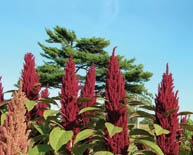Resurrecting the oldest grain

Amaranth, the mystical grain of the Aztecs. As well, the plant symbolizes immortality in Milton's Paradise Lost and other poetry.
Amaranth is a crop with a story to tell. It's also one looking at a successful new life, thanks in part to Philippe Séguin, Bruce Gélinas and the testing fields of Macdonald Campus.
The story begins 6,000 years ago, the earliest documented use of the grain, when Incan and Aztec farmers in South and Central America grew it for sustenance. Milled as flour, sometimes eaten as porridge or popped like corn, it was a hardy crop that predated maize and would eventually rival its ubiquity. It is also the oldest grain to be grown in the U.S.

Philippe Seguin, professor of plant science and amaranth advocate
Owen Egan
But amaranth came up against a powerful force. It was banned in Latin America in the 16th century by the Spanish conquerors who did not take kindly to natives mixing into the popped grains animal blood and turning it into religious-like figurines.
Despite the ban, the grain lived on in obscurity and eventually regained popularity in South and Central America. In the '70s, an environmental farming pioneer named Robert Rodale began to look into the amaranth seed for its nutritional properties. Since then, many nutritionists have marveled over its high calcium content and the fact that it is richer in protein than wheat, barley or rye.
These days, there has been a growing interest in amaranth from people suffering from celiac disease who can't consume goods made with gluten, and those simply interested in eating a nutritious ancient whole grain. Because it has no leavening or glutinous properties, it is often mixed with other grains and used in bread, muffins and pasta.
The grain with a storied past and a promising economic future is now being test-grown for its adaptability to our climate, thanks to a grant awarded to McGill from the Fédération des producteurs de cultures commerciales du Québec.
"This is the first time extensive trials are being done in Quebec," said Philippe Séguin, a professor in the Department of Plant Science who specializes in new crops and new uses for old crops. He is overseeing the testing of 30 amaranth varieties at Macdonald, winnowed down from its current 3,000 varieties.
The first major planting of amaranth in Quebec was at the Lods Agronomy Research Centre last summer and, in a few days, master's student Bruce Gélinas will be planting seeds for the crop's second year.
Gélinas spent the winter analyzing the seeds that come from the plant that sports purple, orange, red or gold flowers. He has chosen 10 promising varieties that seem to be adapting to Quebec soils. They did very well last summer, a season that provided ideal growing weather. He says he's actually hoping for a lousy summer to test how well the often difficult crop does in different conditions.
For a recent get-together with his friends, he popped the grains, mixed them with honey and fashioned a sort of granola bar. He said one of his guests, a Mexican friend who grew up eating sweetened amaranth in his native country, loved it.

